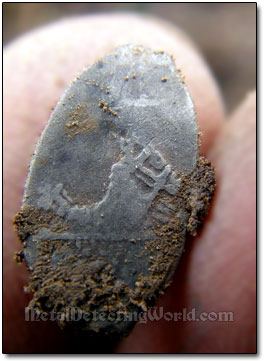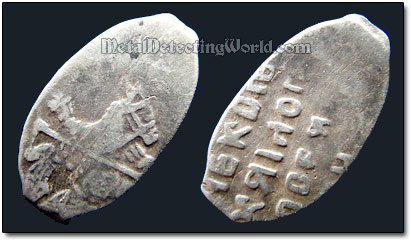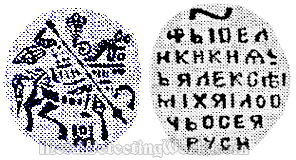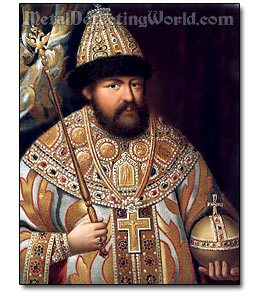Part II: Revisiting the "Virgin" Site of Swedish Tavern, page 68
Metal Detecting Silver Wire Hammered Coins of Tsar Aleksey I Mikhailovich Romanov
Another interesting approach would involve learning and memorizing the AUDIO signal produced by your metal detector when the search coil is over this particular coin. Of course, this would be impossible to do if your detector is not the Multi-Tone machine and does not have the Tone ID.
Although most of coins, both silver and copper, of the same class may "sound" the same even with the Multi-Tone machines, there are some exceptions such as various hammered coins. Their signals are very distinctive and can not be confused with other coins. It is a matter of how well you can hear their peculiar sounds. "He who hears, knows; he who hears not, knows not..."
A Horseman, His Spear and a Horse Head Are Partially Visible on Obverse

By the coin legend on reverse, I determined that this silver wire kopeck was minted during the reign of Tsar Aleksei I Mikhailovich Romanov (1629 - 1676) - the father of Peter I. This kopeck has over 150 varieties!
Silver Wire Kopeck, ca. 1645-1650, Russian Tsar Aleksei I Mikhailovich Romanov (Alexis I)

OBVERSE: a crowned horse rider with a spear, monogram o\M of Moscow Mint under the horse.
REVERSE: six-line legend "ЦАРЬ И ВЕЛИКИЙ КНЯЗЬ АЛЕКСЕЙ МИХАЙЛОВИЧ ВСЕЯ РУСИ " (Tsar and Grand Duke Aleksei Mikhailovich of All Russia).
Weight: 0.46g
Mint: Moscow
The silver kopecks that were hammered during the reign of tsar Alexis I at the Moscow Mint can be divided into three groups on the basis of coins' appearance. These groups correspond to three stages of issue. Stage 1 (1645-1650) consists of early kopecks that began to be issued following Aleksei Mikhailovich's coronation, stage 2 (1650-1655) consists of kopecks issued just before the monetary reform of 1654, and stage 3 (1663-1676) consists of late kopecks that began to be minted after the production of the "alternative" copper coins was stopped.
Only one known variety of the silver wire kopek was issued at the Novgorod mint that had been reopened for the purpose of producing the "replacement" copper coins in 1655. Also known are two varieties of counterfeit silver kopecks that were hammered in big quantities at the European mints. Unlike the counterfeit kopecks produced during the reigns of previous Russian rulers, the forgeries bearing the name of Aleksei Mikhailovich are hard to distinguish from genuine coins.
The only way to identify these forgeries is by weighing. The most common weight of counterfeit kopecks is 0.39g and 0.40g, which is considerably smaller than the weight of genuine silver kopecks of Aleksei I - 0.46g. All forgeries were made with use of "trussell" or "puncheon" (an iron rod with a die bearing only a certain part of coin design) that was widely used in coinage in Western Europe in the 16th and 17th centuries.
This particular wire kopeck belongs to the Group 1 which consists of more than 60 varieties. Whether it is a genuine or counterfeit kopeck, I do not know as I do not have the means of determining its exact weight. Complete obverse and reverse designs of this coin are shown below (not to scale as the reverse design is twice the size of the obverse design).
Drawing of Obverse and Reverse Designs of 1645-1650 Silver Kopeck of Tsar Alexis I

Brief Historical Facts on Aleksey I Mikhailovich Romanov and His Monetary Reform:

Aleksey I Mikhailovich Romanov (also Alexis I of Russia, 1629 - 1676) was the Tsar of Russia (1645 - 1676) during some of the most eventful decades of the mid-17th century. He acquired a nickname the "Quietest One" or "most peaceful" because the essence of his epicurean personality reflected the avoidance of pain and emotional disturbance, and advocated the pursuit of pleasures that can be enjoyed in moderation. Aleksei had an optimistic Christian faith, was attached to the traditions and ritual of the Church, and desired to see everyone around him happy and at peace.
One of the characteristic events of his reign was the 1654 monetary reform caused by wars, shortage of money, shortcomings of the backward monetary system and geographical expansion of Russia. The main goal of Aleksei's reform was to replace the silver kopecks with copper coins in order to make a big profit for the state.
Aleksei started his reform with debasing silver coins (the weight of a silver kopeck was reduced). This gave Aleksei the possibility to pay 60 times less for coining copper specie compared to the cost of production of silver coins. In 1655, both the massive emission of copper wire coins of denominations Altynnik (3 Kopecks), Groschevik (2 Kopecks), Kopeck and Denga, and replacement of all small silver money commenced.
Sudden introduction of copper coins led to people's distrust and refusal of peasants and military people to use the "new" money. Within next seven years the silver coins had disappeared from circulation, counterfeiting of copper coins had risen to unacceptable levels, and the copper coins lost most of their value. Huge inflation eventually caused a massive "copper rebellion" in Russia in 1662. The latter compelled Aleksei I to reverse his reform and resume issuing silver coinage. The archaic monetary system remained in Russia for more than another 36 years. Although Aleksei's reform completely failed, it laid out a "road map" for his son's monetary reform of 1698.
Results of other implemented reforms of Aleksei I Mikhailovich: Taxation reform led to "salt rebellion", Church reform led to the "Schism of Old Believers". Despite the outcomes of Aleksei's reforms, his other policies led to improvement in foreign affairs: the old Russian territories along the left bank of Dnieper river was regained and enforced, and Russia's position in relationship with Sweden had been strengthened. And, overall, the order in Russia was improved as well.